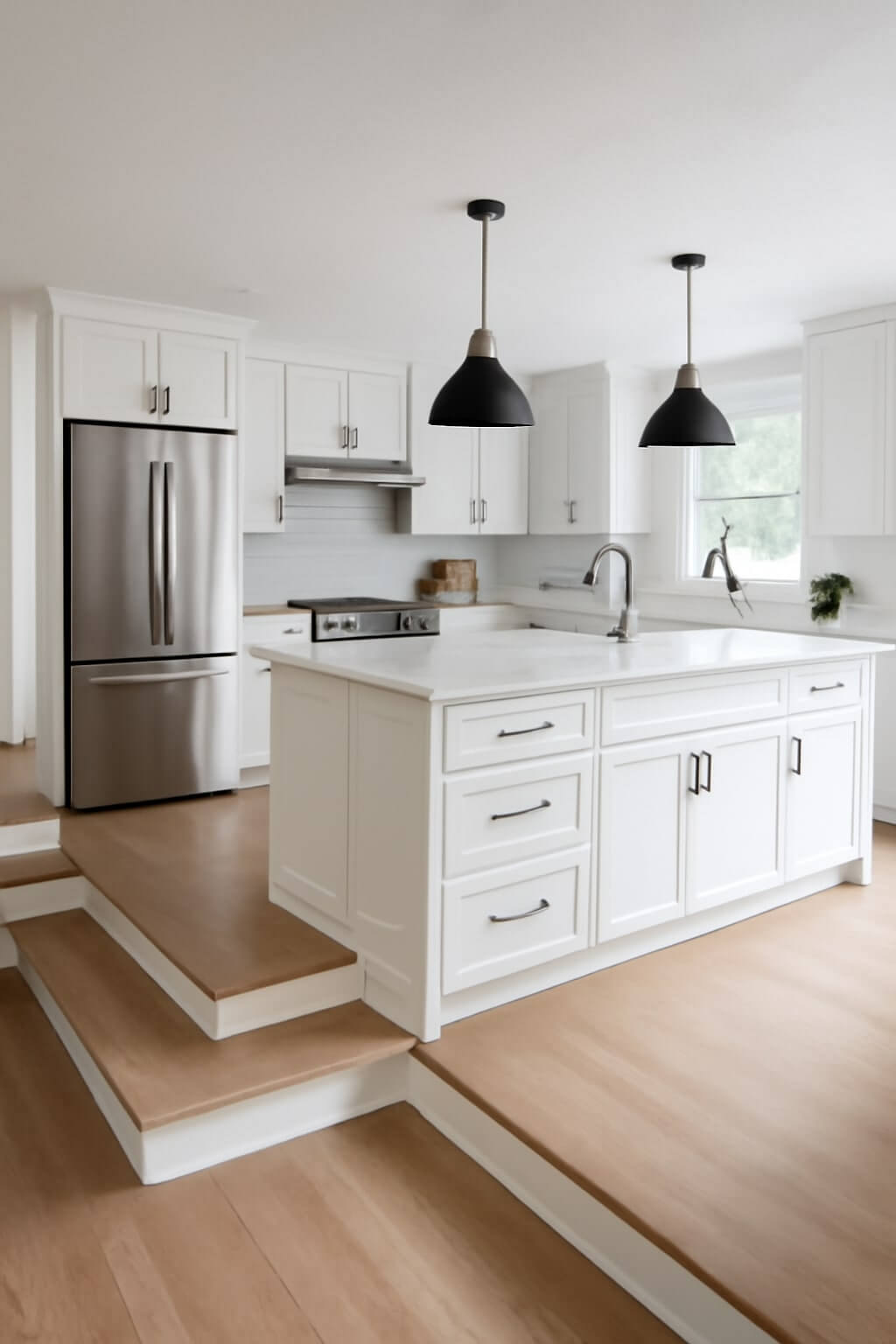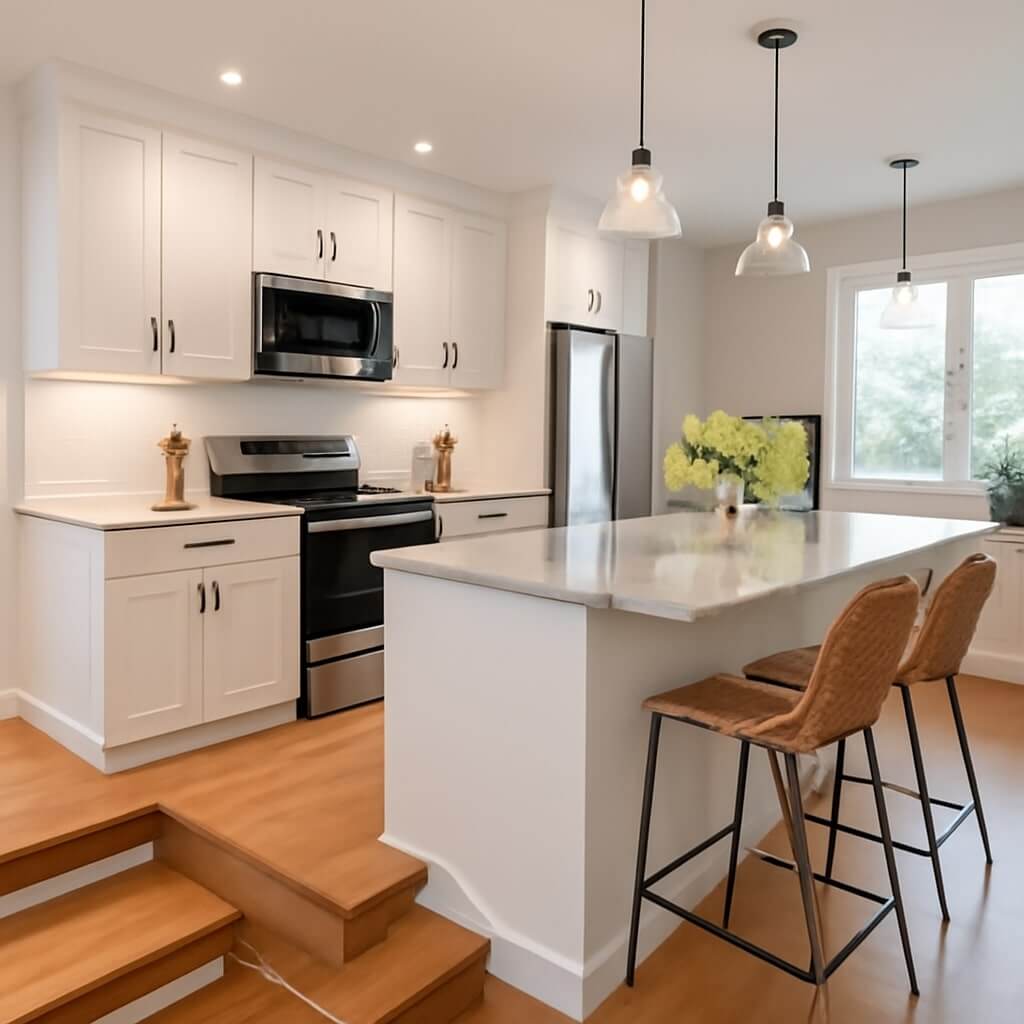Creating your own kitchen remodel estimate template is an essential step in managing your project costs effectively. It helps you track everything from materials and labor to permits and appliances. By customizing your template, you can better align your budget with your project’s scope. However, understanding the components that go into an accurate estimate is just the beginning. Let’s explore how to gather the necessary information and identify key components for your remodel.
Key Takeaways
- Begin by outlining your overall budget, detailing costs for materials, labor, and permits to ensure comprehensive estimates.
- List preferred materials and fixtures, including their costs, to align with your kitchen design vision.
- Include labor costs by evaluating local rates and potential project complexities that may affect hours required.
- Create a section for tracking project scope changes, as they can significantly impact your overall estimates and budget.
- Regularly update your template with real-time data on costs and timelines to maintain accuracy throughout the renovation process.
Understanding the Importance of a Customized Estimate
When you begin a kitchen remodel, understanding the importance of a customized estimate can greatly impact your project’s success.
Customized estimates allow you to align your budget with your project scope, ensuring you account for every detail, from materials to labor costs. By tailoring your estimate to your specific needs, you can avoid unexpected expenses and delays.
It also helps you communicate effectively with contractors, providing a clear framework for the work ahead. A precise estimate empowers you to make informed decisions, ultimately leading to a smoother renovation process and a kitchen that meets your vision and practical requirements.
Gathering Necessary Information for Your Estimate
To create an accurate kitchen remodel estimate, you need to gather specific information regarding your budget, material preferences, and labor costs.
Start by determining how much you’re willing to spend, as this will guide your choices throughout the project.
Next, consider the materials you want to use and get an understanding of the labor expenses involved to guarantee your estimate reflects the true scope of the remodel.
Budget Considerations
As you begin your kitchen remodel project, understanding budget considerations is essential for accurate estimates.
Effective budget planning and thorough cost analysis will help you avoid unexpected expenses.
Focus on gathering precise information about:
- Labor costs, including contractor fees
- Permits and inspections required by local regulations
- Appliances and fixtures that fit your design
Material Selection
Understanding your budget considerations naturally leads to the next important aspect of your kitchen remodel: material selection. You’ll want to balance material durability with your style preferences. Consider how various materials hold up over time and their aesthetic appeal. Here’s a useful comparison table to help guide your choices:
| Material Type | Durability |
|---|---|
| Quartz Countertops | High |
| Solid Wood Cabinets | Medium |
| Ceramic Tile | High |
| Laminate Flooring | Low |
| Stainless Steel | High |
Choose wisely to guarantee your kitchen is both functional and stylish for years to come.
Labor Costs
While you may have a clear vision for your kitchen remodel, accurately estimating labor costs is essential to avoid budget overruns.
Understanding different labor types and employing effective estimating methods will guarantee you’re well-prepared.
Consider the following:
- Hourly Rates: Know the going rates for different trades, like electricians or plumbers.
- Project Scope: Define the tasks involved and how many labor hours each will require.
- Permits and Regulations: Factor in any necessary permits that might affect labor availability and costs.
Gathering this information will help you create an accurate estimate and keep your project on track financially.
Identifying Key Components of Your Kitchen Remodel
A successful kitchen remodel hinges on several key components that can greatly influence both functionality and aesthetics.
First, consider your kitchen layout; whether it’s an L-shape, U-shape, or galley, the design should enhance workflow.
The kitchen layout—be it L-shape, U-shape, or galley—should always prioritize enhancing workflow.
Next, stay updated on design trends, such as open-concept spaces or smart appliances, which can modernize your kitchen while improving efficiency.
Additionally, think about storage solutions like cabinets and shelving to maximize space.
Lighting plays an essential role too, as it impacts both ambience and functionality.
Creating a Materials List
Creating a thorough materials list is essential for staying organized and on budget during your kitchen remodel. This list helps you track expenses and guarantees you don’t miss any critical items.
Consider including:
- Cabinets and hardware
- Countertops and backsplashes
- Flooring materials
When sourcing materials, take the time to conduct product comparisons. This approach not only helps you find the best prices but also guarantees you’re choosing quality products that meet your design needs.
Estimating Labor Costs
To accurately estimate labor costs for your kitchen remodel, you need to take into account several key factors.
Start by evaluating the hourly wage of the skilled laborers you’ll hire, as this can vary based on their experience and the project’s complexity.
Additionally, local labor rates can greatly impact your overall budget, so research those in your area to make sure your estimates are realistic.
Hourly Wage Considerations
When estimating labor costs for your kitchen remodel, understanding hourly wage considerations is essential. Hourly wage fluctuations can greatly impact your overall budget, especially based on the project’s duration.
You’ll want to account for these variables to get a precise estimate.
- Research local wage rates for different trades.
- Consider seasonal demand, as it can affect prices.
- Factor in potential overtime costs if the project extends beyond the planned timeline.
Project Complexity Factors
As you assess the labor costs for your kitchen remodel, recognizing the complexity of the project is vital, since intricate designs and custom features can greatly increase the labor hours required.
Consider the project scope; detailed layouts, specialized installations, or structural changes will demand more skilled labor and time.
Additionally, timeline estimation is important—longer projects can lead to higher costs due to prolonged labor.
Factor in the coordination between tradespeople as well. Each complexity factor influences your overall estimates, so take the time to analyze these elements carefully to guarantee accurate budgeting and scheduling for your remodel.
Local Labor Rates
Understanding local labor rates is essential for accurately estimating the costs of your kitchen remodel, especially since these rates can vary considerably based on geographic location and market demand.
To guarantee you’re informed and prepared, consider the following:
- Research local wage trends to understand what skilled workers charge in your area.
- Compare regional pricing for different trades, such as electricians, plumbers, and contractors.
- Factor in seasonal fluctuations that may affect labor availability and costs.
Accounting for Additional Expenses
While planning your kitchen remodel, it’s important to account for additional expenses that may not be included in your initial estimate.
Unexpected costs often arise, such as hidden plumbing issues or unanticipated material price increases. To safeguard against these surprises, you should establish a contingency fund—typically around 10-20% of your total budget.
This fund acts as a financial buffer, ensuring you’re prepared for any unforeseen expenses that may pop up during the renovation process.
Organizing Your Estimate Template
To effectively manage your kitchen remodel, organizing your estimate template is essential. A well-structured template layout enhances estimate accuracy and helps you stay on track.
Here are key steps to contemplate:
- Categorize Expenses: Break down costs into sections like materials, labor, and permits.
- Use Clear Labels: Ascertain each line item is clearly labeled for easy reference.
- Incorporate Totals: Include subtotal and total sections to streamline calculations.
Reviewing and Adjusting Your Estimate as Needed
Once you’ve organized your estimate template, it’s important to periodically review and adjust it to reflect any changes in your kitchen remodel.
Regularly reviewing estimates guarantees you’re on track with budget and timelines. When you need to adjust plans due to unexpected costs or design alterations, update your template immediately.
This includes revising material prices or labor costs and recalibrating timelines as necessary. Keep track of any shifts in the project scope, so your estimates remain accurate and reflective of the current situation.
Conclusion
Creating your own kitchen remodel estimate template is a crucial step in managing your project effectively. By carefully outlining materials, labor, permits, and appliances, you’ll maintain a clear overview of costs. Remember to include a section for unexpected expenses and regularly adjust for fluctuating prices. This customized approach not only helps you stay within budget but also fosters better communication with contractors, ensuring your remodeling project aligns with your vision and financial goals.




